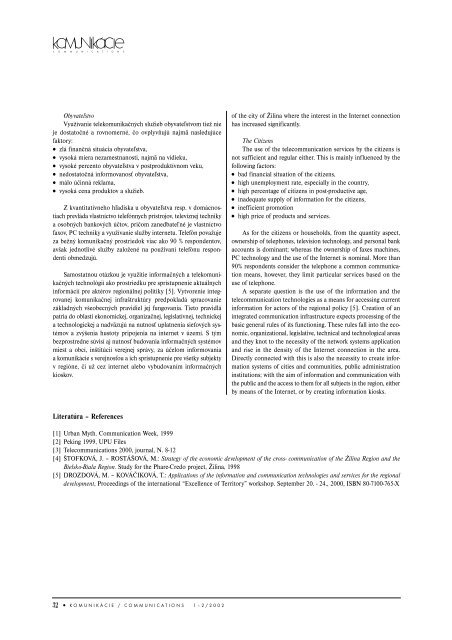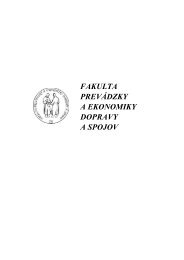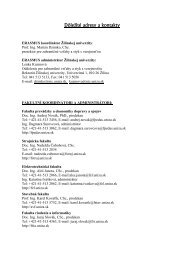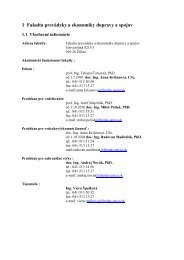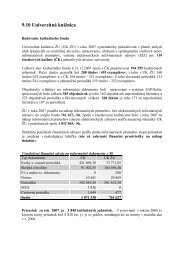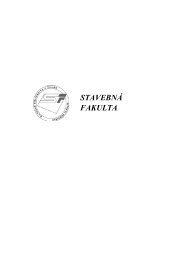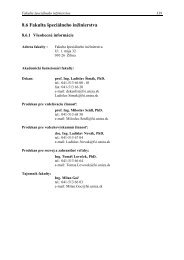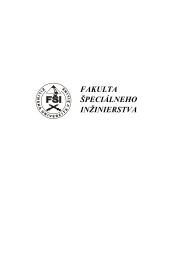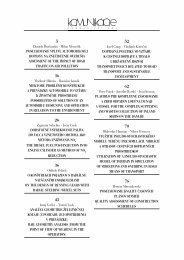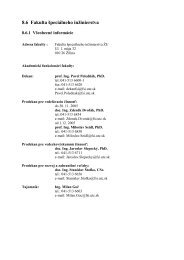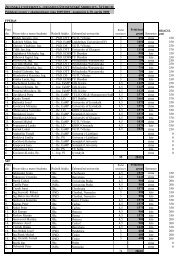n - Žilinská univerzita
n - Žilinská univerzita
n - Žilinská univerzita
Create successful ePaper yourself
Turn your PDF publications into a flip-book with our unique Google optimized e-Paper software.
C O M M U N I C A T I O N S<br />
I S<br />
Obyvateľstvo<br />
Využívanie telekomunikačných služieb obyvateľstvom tiež nie<br />
je dostatočné a rovnomerné, čo ovplyvňujú najmä nasledujúce<br />
faktory:<br />
● zlá finančná situácia obyvateľstva,<br />
● vysoká miera nezamestnanosti, najmä na vidieku,<br />
● vysoké percento obyvateľstva v postproduktívnom veku,<br />
● nedostatočná informovanosť obyvateľstva,<br />
● málo účinná reklama,<br />
● vysoká cena produktov a služieb.<br />
Z kvantitatívneho hľadiska u obyvateľstva resp. v domácnostiach<br />
prevláda vlastníctvo telefónnych prístrojov, televíznej techniky<br />
a osobných bankových účtov, pričom zanedbateľné je vlastníctvo<br />
faxov, PC techniky a využívanie služby internetu. Telefón považuje<br />
za bežný komunikačný prostriedok viac ako 90 % respondentov,<br />
avšak jednotlivé služby založené na používaní telefónu respondenti<br />
obmedzujú.<br />
Samostatnou otázkou je využitie informačných a telekomunikačných<br />
technológií ako prostriedku pre sprístupnenie aktuálnych<br />
informácií pre aktérov regionálnej politiky [5]. Vytvorenie integrovanej<br />
komunikačnej infraštruktúry predpokladá spracovanie<br />
základných všeobecných pravidiel jej fungovania. Tieto pravidlá<br />
patria do oblasti ekonomickej, organizačnej, legislatívnej, technickej<br />
a technologickej a nadväzujú na nutnosť uplatnenia sieťových systémov<br />
a zvýšenia hustoty pripojenia na internet v území. S tým<br />
bezprostredne súvisí aj nutnosť budovania informačných systémov<br />
miest a obcí, inštitúcií verejnej správy, za účelom informovania<br />
a komunikácie s verejnosťou a ich sprístupnenie pre všetky subjekty<br />
v regióne, či už cez internet alebo vybudovaním informačných<br />
kioskov.<br />
of the city of Žilina where the interest in the Internet connection<br />
has increased significantly.<br />
The Citizens<br />
The use of the telecommunication services by the citizens is<br />
not sufficient and regular either. This is mainly influenced by the<br />
following factors:<br />
● bad financial situation of the citizens,<br />
● high unemployment rate, especially in the country,<br />
● high percentage of citizens in post-productive age,<br />
● inadequate supply of information for the citizens,<br />
● inefficient promotion<br />
● high price of products and services.<br />
As for the citizens or households, from the quantity aspect,<br />
ownership of telephones, television technology, and personal bank<br />
accounts is dominant; whereas the ownership of faxes machines,<br />
PC technology and the use of the Internet is nominal. More than<br />
90% respondents consider the telephone a common communication<br />
means, however, they limit particular services based on the<br />
use of telephone.<br />
A separate question is the use of the information and the<br />
telecommunication technologies as a means for accessing current<br />
information for actors of the regional policy [5]. Creation of an<br />
integrated communication infrastructure expects processing of the<br />
basic general rules of its functioning. These rules fall into the economic,<br />
organizational, legislative, technical and technological areas<br />
and they knot to the necessity of the network systems application<br />
and rise in the density of the Internet connection in the area.<br />
Directly connected with this is also the necessity to create information<br />
systems of cities and communities, public administration<br />
institutions; with the aim of information and communication with<br />
the public and the access to them for all subjects in the region, either<br />
by means of the Internet, or by creating information kiosks.<br />
Literatúra – References<br />
[1] Urban Myth. Communication Week, 1999<br />
[2] Peking 1999, UPU Files<br />
[3] Telecommunications 2000, journal, N. 8-12<br />
[4] ŠTOFKOVÁ, J. – ROSTÁŠOVÁ, M.: Strategy of the economic development of the cross- communication of the Žilina Region and the<br />
Bielsko-Biala Region. Study for the Phare-Credo project, Žilina, 1998<br />
[5] DROZDOVÁ, M. – KOVÁČIKOVÁ, T.: Applications of the information and communication technologies and services for the regional<br />
development, Proceedings of the international “Excellence of Territory” workshop. September 20. - 24., 2000, ISBN 80-7100-765-X<br />
32 ● KOMUNIKÁCIE / COMMUNICATIONS 1–2/2002


